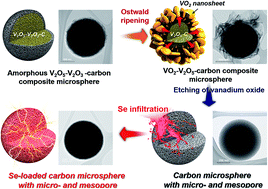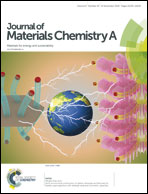Carbon microspheres with well-developed micro- and mesopores as excellent selenium host materials for lithium–selenium batteries with superior performances†
Abstract
As host materials for efficient selenium storage and utilization, porous carbon materials with optimized and suitable pore structures are important in the development of high-performance Li–Se batteries. Herein, the synergetic effect of micro- and mesopores of carbon materials on the conversion reaction of loaded chain-structured Sen is studied for superior Li–Se batteries. Carbon microspheres with well-developed micro- and mesopores are synthesized by spray pyrolysis. Carbon–vanadium oxide composite microspheres synthesized by spray pyrolysis transform into microporous carbon microspheres (P-carbon) by etching of vanadium oxide. An additional post-treatment of the spray-pyrolysis product at 400 °C yields carbon microspheres (A4-carbon) with well-developed micro- and mesopores by etching of vanadium oxide. The presence of both micro- and mesopores in carbon is desirable to achieve a fast conversion reaction of Sen in the Se-loaded carbon microspheres. The Se-loaded carbon microspheres with well-developed micro- and mesopores (A4-carbon/Se) exhibit higher capacities and stable long-term cycling performances compared with similar microspheres with only micropores (P-carbon/Se). The discharge capacities of P-carbon/Se and A4-carbon/Se at the 500th cycle at a current density of 0.5 A g−1 are 403 and 582 mA h g−1, respectively. Moreover, A4-carbon/Se microspheres exhibit a stable reversible capacity of 343 mA h g−1 after 2000 cycles even at a high current density of 2.0 A g−1; their capacity retention calculated from the 3rd cycle is 87%.



 Please wait while we load your content...
Please wait while we load your content...